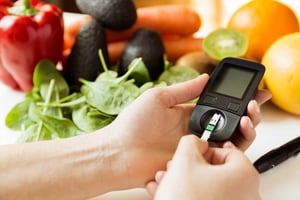 Diabetes is a chronic health condition that effects how your body turns the foods you eat into energy. If you have diabetes, your body either doesn’t make enough insulin or can’t use the insulin it makes as well as it should. The food you eat greatly influences your blood sugar levels, so learning to eat well with diabetes can help you to live a healthier and happier life. Before we begin our best plan for eating with diabetes, let’s review the basics of the condition.
Diabetes is a chronic health condition that effects how your body turns the foods you eat into energy. If you have diabetes, your body either doesn’t make enough insulin or can’t use the insulin it makes as well as it should. The food you eat greatly influences your blood sugar levels, so learning to eat well with diabetes can help you to live a healthier and happier life. Before we begin our best plan for eating with diabetes, let’s review the basics of the condition.
Diabetes Basics
Most of what you eat is digested and broken down into glucose, aka, “blood sugar” which is released into your blood. As the amount of glucose in your blood rises after a meal, your pancreas releases insulin. Insulin acts as a key that opens the “door” to the cells in your body, allowing glucose to enter and be used as energy. When you don’t make insulin or your cells don’t respond to it as well as it should, too much glucose stays in your bloodstream. Over time, this can cause damage to your heart, vessels, kidneys, and eyes and can have many other detrimental effects.
There isn’t a cure for diabetes, but you can manage the condition by losing weight, eating the right kinds of foods at the right time, and being more physically active- while keeping medical appointments with your healthcare provider and keeping blood sugar records.
Diabetes & Meal Planning
A meal plan is a guide that tells you what to eat, how much, and what time to eat that will help keep your blood sugar targets in the right range. Ask your healthcare provider for what pre and post meal ranges are right for you. Every body is different and working with your blood sugar records over time is the best way to determine how different foods effect your sugar levels.
Carbohydrates
Carbohydrates, (or carbs as they are commonly called) in the food you eat raise your blood sugar levels. They are mainly found in processed foods, breads, rice, pastas, sweets, as well as fruits, starchy vegetables and some dairy products like milk or yogurt. How fast carbs raise your blood sugar depends on what the food is and what you eat with it. For example, drinking fruit juice raises blood sugar faster than eating a piece of whole fruit. Eating carbs with foods that have protein, fat, or fiber slows down how quickly your blood sugar rises.
Planning regular, balanced meals about every 2-3 hours can help to avoid high or low blood sugar levels. Eating a consistent amount of carbohydrates with each meal can also help you to stay within normal ranges. There are two main ways that diabetics can plan to eat consistently to maintain a healthy blood sugar: The Plate Method and Carb Counting.
The Plate Method

- Use a 9 inch plate for all meals (roughly the length of a business envelope)
- Make half of your plate fruits and non-starchy vegetables like broccoli, spinach, peppers, zucchini, mushrooms, butternut squash
- Make one-quarter of the plate a lean protein (approx. 3-4 oz.) such as chicken without skin, white fish, salmon, turkey, tuna, tofu or pork. You can include beef, just keep in mind that the loin, eye, and round are usually the leanest cuts
- Make the other quarter of your plate a whole grain OR starchy vegetable (approximately 1/3 cup) whole grain rice, whole grain pasta, beans, corn, baked potato, sweet potato
- Add a no calorie beverage like water, diet soda, flavored seltzer or diet tea- drinking sugary beverages will only raise your blood sugar levels quickly for no nutrition
Carb Counting
Keeping track of how many carbs you eat and setting a limit for each meal can help keep your blood sugar levels in your target range. Work with your doctor or a registered dietitian to find out how many carbs you can eat each day and at each meal. This is a list of common foods that contain carbohydrates and their appropriate portion sizes:
Each is approximately 15 g carbohydrate
| Starchy Vegetables | Fruits | Starches |
|---|---|---|
| ½ cup cooked green peas | 1 small fresh fruit; apple | 1 slice of bread |
| ½ cup cooked corn | ½ cup 100% fruit juice | ½ English muffin |
| ½ corn on the cob, large (5 oz.) | ½ banana | 1 pancake or waffle |
| ½ cup cooked hominy | 2 T dried fruit (raisins) | 1 tortilla |
| ½ cup cooked sweet potatoes | 4 apricots | ¼ of large bagel |
| ½ cup cooked potatoes | 1 cup melon cubes | 2 oz. of corn bread |
| 1 small potato or sweet potato | 1 cup blueberries | ½ pita |
| ½ cup hash browns or au gratin potatoes | 1 cup raspberries | ¼ granola |
| 10 to 15 French fries | ¾ cup pineapple | ½ cup cooked cereal |
| 1 cup winter squash (pumpkin, acorn, butternut) | ½ mango or papaya | ¾ dry cereal |
| 1 cup marinara or pasta sauce | 15 grapes | ½ cup sugar frosted cereal |
| ½ cup tomato juice | Dairy Products | 1/3 cup brown or white rice |
| ¼ cup tomato puree | 1 cup of milk | 1/3 cup cooked pasta |
| Legumes | 6 oz. cup of yogurt with sweetener | 6 saltine or Ritz crackers |
| ½ cup boiled beans (kidney, pinto, red, green, etc.) | Sweets | 15 mini pretzels |
| ½ cup refried beans | 2 in square cake, unfrosted | 3 cups of popcorn |
| ½ cup cooked lentils | 2 small cookies | |
| ¼ cup baked beans |
This list is not exhaustive and more information can be found at https://www.diabetes.org/healthy-living/recipes-nutrition/understanding-carbs/carb-counting-and-diabetes.
Living with diabetes can be challenging. With careful education and meal planning, you can help manage your weight and your blood sugar levels. Always consult with your healthcare provider before making significant changes to your diet and lifestyle.
Clinical Trials
Here at Chase Medical Research we often have ongoing trials for individuals with Diabetes. If you are interested in participating in a heart disease trial or any one of our other trials, don't hesitate to check out our website for currently enrolling trials.
References:
- American Diabetes Association. Standards of medical care in diabetes 2020. Diabetes Care: The Journal of Clinical and Applied Research and Education. Jan 2020. 43; 1. Accessed 13 June: https://care.diabetesjournals.org/content/diacare/suppl/2019/12/20/43.Supplement_1.DC1/Standards_of_Care_2020.pdf.
Share This Post
Recent Posts
- The Relationship Between Obesity and Obstructive Sleep Apnea June 25 2021
- Cardiovascular Outcome Clinical Trials June 25 2021
- Diabetic Peripheral Neuropathic Pain June 25 2021
- Are All Types of Cholesterol Bad? June 25 2021
- Blood Pressure: The Highs, the Lows, and Everything in Between June 25 2021
Categories
- Clinical Trials
- Cardiovascular Disease
- Diabetes
- Obesity
- Kidney Disease
- Hypertension
- Pain Management
- Vaccine
- Cholesterol
- Chronic Obstructive Pulmonary Disease
- Diabetic Peripheral Neuropathy
- Migraine
- Osteoarthritis
- Biologics
- COVID-19
- Gastroesophageal Reflux Disease
- Irritable Bowel Syndrome with Constipation
- Lyme Disease
- Nonalcoholic Steatohepatitis
- Respiratory Syncytial Virus


